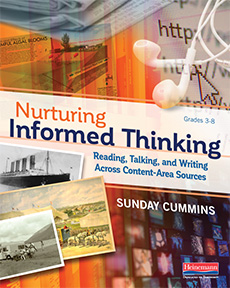Integrating Multiple Nonfiction Texts
Nurturing Informed Thinking: Reading, Talking, and Writing Across Content-Area Sources
By Sunday Cummins
(Heinemann, 2018 – Learn more)
Reviewed by Mary K. Marsh
Be sure to have your favorite highlighter in hand and sticky tabs nearby when you begin reading Nurturing Informed Thinking: Reading, Talking, and Writing Across Content-Area Sources by Sunday Cummins.
It’s a book filled with practical and inspiring ideas for meaningful teaching by using multiple nonfiction sources on a topic. Both content area and ELA teachers will find this book an enormously valuable resource.

High-stakes state tests also require students to use multiple texts with a similar focus on information integration. Nurturing Informed Thinking takes this intersection of needs and creates an effective road map of instructional pathways to meet this goal.
Emerging from Cummins’ own professional inquiry experiences, Nurturing Informed Thinking guides teachers in selecting and presenting multiple sources on one topic. The emphasis is on closely reading several non-fiction sources about a particular topic so that students can analyze and synthesize information. Classroom examples abound, making her approach feel highly do-able.
Cummins focuses on making the use of multiple sources manageable for both teachers and students. For example, she suggests using one short text or excerpt, one graphic, and one video clip when creating a source set for a topic. Well-organized examples of lessons and suggestions for teacher talk provide additional support for implementation.
Lessons backed with instructional moves
Throughout the book, Cummins emphasizes the need for teachers to set a clear purpose for reading, the critical role of teacher modeling, and the importance of conferring to support student learning. Nine lesson ideas (presented in Chapter 3) lay the groundwork for successful implementation.
Teaching non-fiction reading can be a complex challenge, but the book’s lesson ideas set out a foundation for the regular use of multiple informational text sets. The lessons could be easily used to try out teaching with informational text sets and can also serve as mini lessons during a unit.
Additionally, Nurturing Informed Thinking describes six instructional moves (presented in Chapter 4) which support student learning across lessons or units. Together, the lesson ideas and instructional moves give teachers a cohesive approach to teaching students how to read and interpret multiple documents on one topic for meaningful learning.
A good fit for a variety of classroom structures
Teachers already implementing reading and writing workshop models will be able to smoothly integrate the ideas in Nurturing Informed Thinking. Teachers with self-contained classrooms should find that the ELA skills and content area requirements work well together in this approach. It would also fit well with Understanding by Design and the variety of project-based learning or inquiry approaches many schools are now encouraging.
Content-area teachers will find guidance in teaching reading skills that also genuinely develop content knowledge. Subject area teachers often have the goal of students using multiple sources (and face standards requiring the use of documents), but they may start instruction without realizing that students first need to develop specific reading skills to interpret fully the sources and documents. Or the instructional emphasis may be solely on the content of the document.
Nurturing Informed Thinking gives teachers ways of expanding instruction to focus on analysis and synthesis. Geared for grades 3-8, the book gives enough explicit reading instruction directives to guide non-ELA teachers. However, if upper grade content area teachers do not have an ELA background, they may want to find some additional support or information for the conferencing aspects of Cummins’ approach.
Guidance on adjusting scaffolding
Since Nurturing Informed Thinking emphasizes giving students the opportunity to examine multiple informational source sets on a consistent, on-going basis, it also shows how to adjust scaffolding to increase student independence. Cummins also demonstrates how students can use inquiry charts, or I-charts, to organize information. This provides a springboard for subsequent writing about the topic or other projects.
The comprehensive and practical approach of Nurturing Informed Thinking makes it an excellent addition for your professional development bookshelf. Easy to read with many helpful graphics, Nurturing Informed Thinking is a resource that helps teachers expand and refine their practice in an area of growing importance.
The ability of students to examine and analyze a variety of informational sources about a single topic is increasingly essential, and Nurturing Informed Thinking advances our expertise in helping them develop this skill.
Currently, Mary K. Marsh teaches middle school social studies in Bellbrook, OH. She is also a reading specialist trained in Reading Recovery.


































